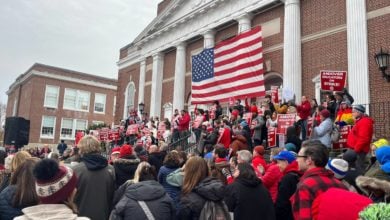Photo: Current Supreme Court justices
Today, the Supreme Court proved yet again its vicious anti-worker character by ruling against the student debt relief program and ordering tens of millions of borrowers to pay hundreds of billions of dollars that would otherwise have been forgiven. This is a huge attack that piles on even more economic pain amid inflation and a possible recession.
Forty-three million people in the United States are burdened by debt from student loans — totaling $1.75 trillion. This outrageous state of affairs stems from the fact that under capitalism education is treated as a commodity to be bought and sold. Universities are run like businesses, with the goal of squeezing as many tuition dollars as possible out of their students. Over the last 30 years, inflation-adjusted tuition for public colleges doubled and now stands at $10,740 a year. The increase was even more dramatic at private colleges, ballooning by nearly 150% to $38,070.
Hardly any worker can afford to pay these huge sums out of pocket. Debt has filled the gap, skyrocketing to the point where the amount owed to lenders is now the same size as the entire economy of South Korea.
While Biden is the one who issued — under intense pressure — the executive order on debt relief, it is important to remember how he earlier had helped make the crisis much worse. As a Senator, Biden was a key backer of a landmark 2005 bankruptcy law that greatly strengthened the hand of creditors at the expense of borrowers. One of the key provisions of that law was to make it virtually impossible to have student debt wiped out in a bankruptcy. Thanks to the efforts of Biden and his colleagues in Congress, student loans have a special status that allows them to follow people for the rest of their lives, even if they go completely broke trying to repay it.
Biden now says he will use provisions in the Higher Education Act — instead of the HEROES Act — to pursue a new student debt relief program. He should have done that in the first place. But his goal in August when he announced the original program was to boost the dismal popularity of the Democrats heading into the midterm election — its ability to withstand a legal challenge after the vote in November was of secondary importance.
Supreme Court pushes dangerous legal doctrine
The court’s decision to overturn student debt relief is the latest instance of the “major questions doctrine” being used as a weapon against workers. To the extent that there are any restrictions placed on the right of corporations to exploit the people and the planet for profit, they are often imposed by regulatory agencies that are part of the executive branch of government. These agencies have been empowered to take action to enforce things like clean air or safety standards, and have discretion to issue new rules to keep up with the evolving nature of different industries.
The major questions doctrine in essence says that no such authority can exist under the constitution. On any “major question” affecting society, right-wing lawyers argue, no measure can be carried out that is not explicitly authorized by Congress. This leaves only the most mundane issues that are least likely to impact corporate profit for regulatory agencies to deal with.
The justices cited the major questions doctrine in their ruling overturning student debt relief. It has also been used recently to overturn the nationwide eviction moratorium and eliminate the Environmental Protection Agency’s ability to regulate greenhouse gas emissions that cause climate change.
This legal theory is a massive gift to the ultra-rich. The executives who sit on corporate boards — and sometimes lavish justices with luxury gifts — are who the Supreme Court truly serves. The right of everyone else to get an education, live in a home or breathe clean air is of no importance to the court. It is long past time for this rotten institution to be abolished.




